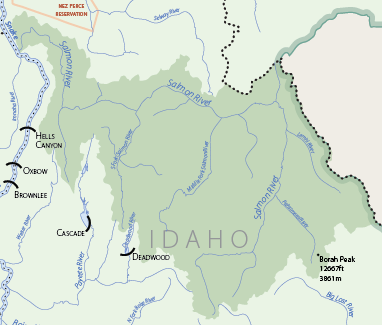
Salmon River Subbasin Management Plan
The Salmon Subbasin Management Plan is the third volume of the Salmon Subbasin Plan. The Salmon Subbasin Plan was developed as part of the Northwest Power and Conservation Council’s (NPCC) Columbia River Basin Fish and Wildlife Program to help direct Bonneville Power Administration’s (BPA) funding of projects in the Salmon subbasin that mitigate for damage to fish and wildlife caused by the development and operations of the Columbia River’s hydropower system. The Salmon Subbasin Management Plan was developed in an open public process that included the participation of a wide range of state, federal, local, and tribal governments, local managers, landowners, and other stakeholders; a process the NPCC hopes will ensure support of the final plan and direct funding to fish and wildlife projects that will do the most good.
An adopted subbasin plan is intended to be a living document that increases analytical, predictive, and prescriptive ability to restore fish and wildlife. The Salmon Subbasin Plan will be updated every three years to include new information that will enable the revision of the biological objectives, strategies, and implementation plan. The NPCC views plan development as an ongoing process of evaluation and refinement through adaptive management, research, and evaluation. More information about subbasin planning can be found at http://www.nwcouncil.org.
Due to its large size, the Salmon subbasin was split between two working groups: the Upper Salmon and Lower Salmon working groups. The Idaho Department of Fish and Game (IDFG) was the lead entity responsible for completing a subbasin assessment and inventory for both the Upper and Lower Salmon. The Nez Perce Tribe (NPT) was the lead entity responsible for developing the portions of the plan for the Lower Salmon; the Shoshone-Bannock Tribes (SBT) was the lead entity responsible for developing the portions of the plan for the Upper Salmon. Issues in the Middle Fork Salmon River were addressed within the upper and lower working groups. Both the Nez Perce Tribe and the Shoshone-Bannock Tribes contracted with Ecovista to coordinate the planning process and to write the management plan volume of the subbasin plan. Issues in the Middle Fork Salmon River were addressed within both the upper and lower working groups. The lead entities and Ecovista integrated the lower and upper subbasin efforts into a single, unified subbasin plan. The lead entities submitted the completed Salmon Subbasin Management Plan to the Council on May 28, 2004.
The Salmon Subbasin Plan includes three interrelated volumes that describe the characteristics, management, and vision for the future of the Salmon subbasin:
Assessment (Volume 1)—The assessment examines the biological potential of the Salmon subbasin to support key habitats and species, and limiting factors that reduce this potential. The assessment describes existing and historic resources and conditions within the subbasin, focal species and habitats, environmental conditions, out-of-subbasin impacts, ecological relationships, and limiting factors, and it provides a final synthesis and interpretation.
Inventory (Volume 2)—The inventory summarizes fish and wildlife protection, rehabilitation, and artificial production activities and programs within the Salmon subbasin over the last five years or that are about to be implemented. The inventory includes a GAP analysis that analyzes the ability of existing projects to address needs identified in the management plan.
Management Plan (Volume 3)—The management plan defines a vision for the future of the subbasin, and outlines biological goals and strategies to restore and protect aquatic and terrestrial species and habitats to be implemented during the next 10 to 15 years. The management plan includes a research, monitoring, and evaluation plan to determine the success of implemented strategies in addressing limiting factors and to reduce uncertainties and data gaps. The management plan also includes information about the relationship between proposed activities and the Endangered Species Act (ESA) and Clean Water Act (CWA). The management plan prioritizes objectives and strategies and concludes with final management recommendations.
The completed Salmon Subbasin Management Plan was submitted to the NPCC by the Nez Perce Tribe Watershed Division and the Shoshone-Bannock Tribes on May 28, 2004.





 Subbasin plans are stored on the Northwest Power and Conservation Council’s website. All links will open on their website.
Subbasin plans are stored on the Northwest Power and Conservation Council’s website. All links will open on their website.

